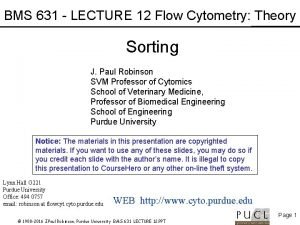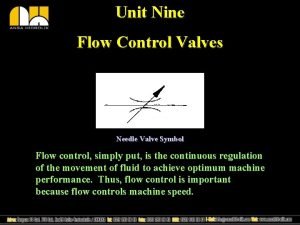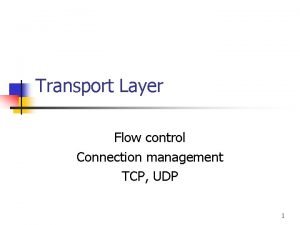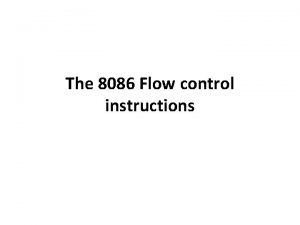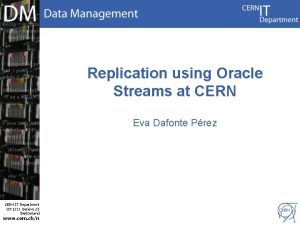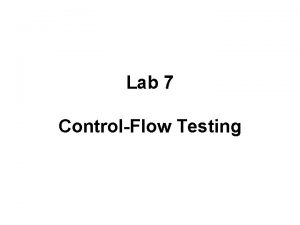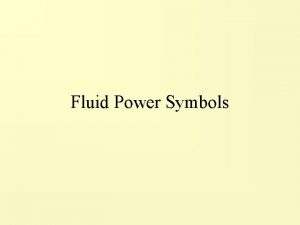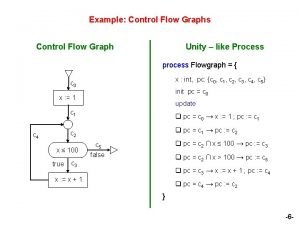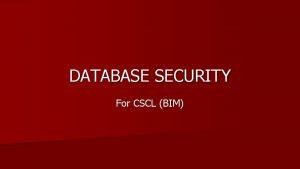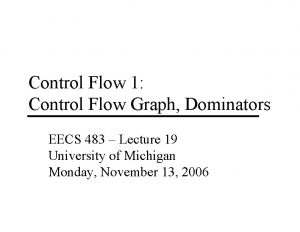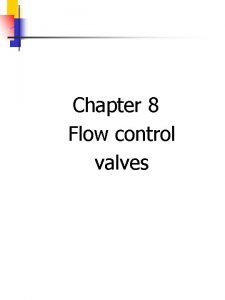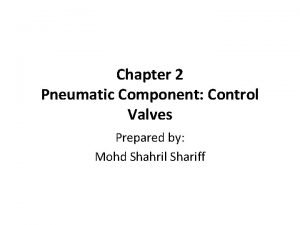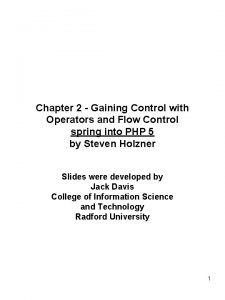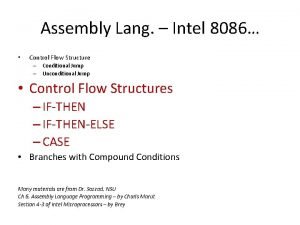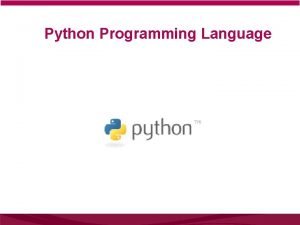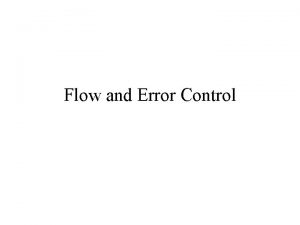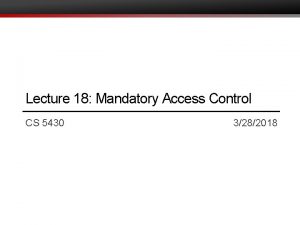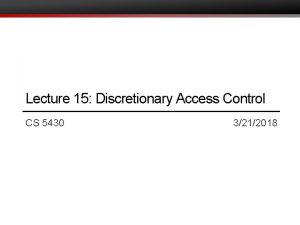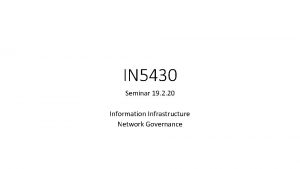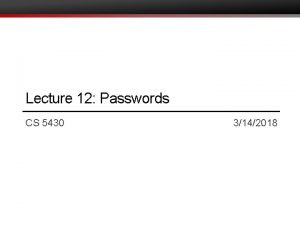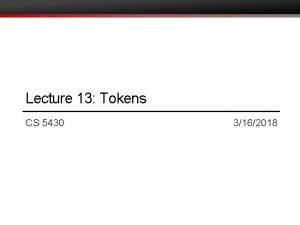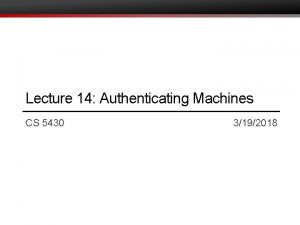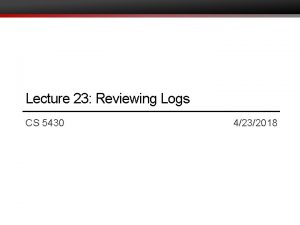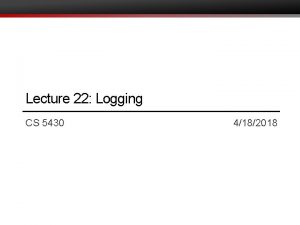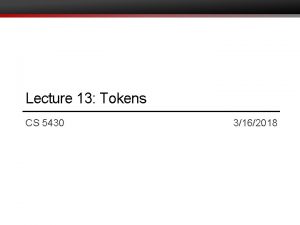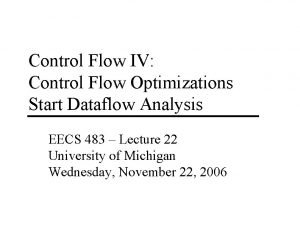Lecture 20 Information Flow Control CS 5430 4112018




![5 Noninterference [Goguen and Meseguer 1982] An interpretation of noninterference for a program: • 5 Noninterference [Goguen and Meseguer 1982] An interpretation of noninterference for a program: •](https://slidetodoc.com/presentation_image_h2/6c12f603903e6609dc0c5021b4266a2e/image-5.jpg)





































- Slides: 42

Lecture 20: Information Flow Control CS 5430 4/11/2018

2 Information flow policies Doc Can flow to: Alice Automatic deduction of policies! computation Can flow to: Alice Doc’’ Can flow to: Alice

Labels represent policies Secret, {nuc, crypto} Secret, {nuc} Conf, {nuc, crypto} Secret, {crypto} Conf, {nuc} Secret, {} Conf, {crypto} Conf, {}

Labels represent policies High Low
![5 Noninterference Goguen and Meseguer 1982 An interpretation of noninterference for a program 5 Noninterference [Goguen and Meseguer 1982] An interpretation of noninterference for a program: •](https://slidetodoc.com/presentation_image_h2/6c12f603903e6609dc0c5021b4266a2e/image-5.jpg)
5 Noninterference [Goguen and Meseguer 1982] An interpretation of noninterference for a program: • Changes on H inputs should not cause changes on L outputs. H H L L Inputs Program Outputs

6 Today: Information Flow Control •

7 Information Flow Control H H L Inputs L H Output s L L Label Variabl e Progra m

8 H L H L L

9 H L L H H

10 Enforcing IF policies • Static mechanism • Checking and/or deduction of labels before execution. • Dynamic mechanism • Checking and/or deduction of labels during execution. • Hybrid mechanism • Combination of static and dynamic.

STATIC TYPE CHECKING

A simple programming language e : : = x | n | e 1+e 2 |. . . c : : = | | | x : = e if e then c 1 else c 2 while e do c c 1; c 2

13 Checking an assignment x : = y Examples for confidentiality

14 Checking an assignment Assignments cause explicit information flows. x : = y

15 Checking an assignment x : = y

16 Checking an assignment x : = y

17 Checking an assignment x : = y + z ? ? ?

18 Operator for combining labels •

19 Checking an assignment x : = y + z

20 Lattice of labels • Secret, {nuc, crypto} Secret, {nuc} Conf, {nuc, crypto} Secret, {crypto} Conf, {nuc} Secret, {} Conf, {crypto} Conf, {}

21 Checking an if-statement if z > 0 then x: = 1 else x: = 0 Examples for confidentiality

22 Checking an if-statement if z > 0 then x: = 1 else x: = 0 Conditional commands (e. g. , if-statements and while-statements) cause implicit information flows.

23 Context if z > 0 then x: = 1 else x: = 0 They reveal information about z>0.

24 Context if z > 0 then x: = 1 else x: = 0 Implicit flow Explicit flow

25 Typing system for IF control •

26 We are already familiar with typing systems! Example of typing rule from Java or OCaml: x + y : int if x : int and y : int

27 Typing rules for expressions • Constant: G⊢n: ⊥

28 Typing rules for expressions Inference rule: Premise s Conclusio n G⊢e: ℓ G ⊢ e’ : ℓ’

29 Example •

30 Typing rules for commands •

31 Assignment rule • G⊢e: ℓ

32 If-rule G⊢e: ℓ

33 If-rule (example)

34 Static type system Assignment-Rule: If-Rule: G⊢e: ℓ While-Rule: Sequence-Rule: G⊢e: ℓ

35 Soundness of type system •

36 Limitations of the type system

37 This type system does not prevent leaks through covert channels. •

38 A solution • To prevent covert channels due to infinite loops, • strengthen the typing rule for while-statement, to allow only low guard expression: • Now, type correctness implies termination sensitive NI. • But, the enforcement mechanism becomes overly conservative. • Another solution? Research!

39 This type system is not complete. •

40 This type system is not complete. •

41 Can we build a complete mechanism? • Is there an enforcement mechanism for information flow control that has no false negatives? • A mechanism that rejects only programs that do not satisfy noninterference? • No! [Sabelfeld and Myers, 2003] • “The general problem of confidentiality for programs is undecidable. ” • The halting problem can be reduced to the information flow control problem. • Example: if h>1 then c; l: =2 else skip • If we could precisely decide whether this program is secure, we could decide whether c terminates!

42 Can we build a mechanism with fewer false positives? Switch from static to dynamic mechanisms!
 Data flow vs control flow
Data flow vs control flow Control flow and data flow computers
Control flow and data flow computers Transaction flow testing
Transaction flow testing 01:640:244 lecture notes - lecture 15: plat, idah, farad
01:640:244 lecture notes - lecture 15: plat, idah, farad Stock control e flow control
Stock control e flow control Control flow error
Control flow error Flow cytometry lecture
Flow cytometry lecture Healthmis.ng
Healthmis.ng Magic box respiratory
Magic box respiratory High flow versus low flow oxygen
High flow versus low flow oxygen T piece ventilation
T piece ventilation Annubar vs pitot tube
Annubar vs pitot tube External flow
External flow Flow energy review
Flow energy review Flow of energy vs flow of matter
Flow of energy vs flow of matter Transform flow and transaction flow in software engineering
Transform flow and transaction flow in software engineering Data flow structure
Data flow structure Irrotational flow
Irrotational flow Internal and external flow
Internal and external flow Cheese production flow chart
Cheese production flow chart Needle valve symbol
Needle valve symbol Flow control udp
Flow control udp Cmp 8086
Cmp 8086 Exceptional control flow
Exceptional control flow Repl capture/apply: memory
Repl capture/apply: memory Material flow control
Material flow control Control flow graph for bubble sort
Control flow graph for bubble sort Dcv symbols
Dcv symbols Unity flow graph
Unity flow graph Flow control in database security
Flow control in database security Trim valves
Trim valves Blood flow
Blood flow Types of control hijacking
Types of control hijacking Ipdom
Ipdom Cyclomatic
Cyclomatic Deceleration valve symbol
Deceleration valve symbol Supply air throttling and exhaust air throttling
Supply air throttling and exhaust air throttling Supply air throttling in pneumatic system
Supply air throttling in pneumatic system Flow control functions in php
Flow control functions in php Loop in assembly language 8086
Loop in assembly language 8086 Cash flow and cost control
Cash flow and cost control Www.mbaknol.com
Www.mbaknol.com Comparators python
Comparators python






